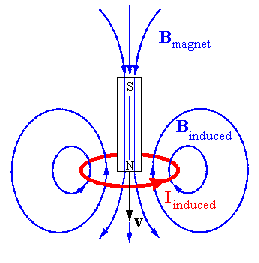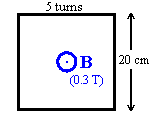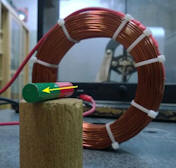 Example:
Example:Faraday's law is one of Maxwell's equations. Faraday's law states that the absolute value or magnitude of the circulation of the electric field E around a closed loop is equal to the rate of change of the magnetic flux through the area enclosed by the loop. The equation below expresses Faraday's law in mathematical form.
ΔΦB/∆t (through a fixed area) = -Σaround loop E∙∆r (at a fixed time)
The minus sign in this equation tells us about the direction of the circulation. (See below.)
When the magnetic flux through the area enclosed
by the loop changes, Σaround loop E∙∆r is not zero, the
electric field E circulates.
E∙∆r is the work done per
unit charge by the electric field in moving the charge a distance ∆r.
If
the loop is an actual wire loop, then there is actual work done by the induced
field on free charges.
Σaround loop E∙∆r is the work
per unit charge by the field in moving the charge once around the loop.
This is
an induced emf,
and it is measured in Volts.
The induced emf causes a current to flow
without a
potential difference due to separated charges.
ΔΦB/∆t (through a fixed area) = induced emf
The induced electric field is NOT a conservative field. When you move a charge against the induced field once around the loop, you have to do work. But your work is NOT stored as potential energy. You cannot let the electric field do work to recover the energy you expended in moving the charge. The induced electric field disappears as soon as the magnetic flux is no longer changing. The work you do on a charge against the induced field is not locally stored. The energy may be transported away in the form of an electromagnetic wave. Electromagnetic waves carry energy through free space.
The minus sign in the equation expressing Faraday's law tells us about the
direction of the induced field.
There is an easy way to remember this direction.
The circulation of the induced field is equal to an emf.
Any current
flowing as the result of that emf produces a magnetic field that opposes the
flux changes that produce it.
This is called
Lenz's law.
An induced emf acts as to oppose the CHANGE in flux that produce it.
 Example:
Example:A magnet is moved quickly towards a wire loop as shown.
The flux through the wire loop is increasing in the downward direction.
A current starts flowing
in the loop in the direction indicated by the arrow.
The magnetic field produced by this current
points upward, it opposes the flux
changes that produce it.
The magnetic force due to the loop on the magnet acts to slow down the
approaching magnet.
The beauty of Lenz's law is that you do not have to look at the details. If the magnetic flux through a conductor changes, currents will flow to oppose whatever caused the change. If some relative motion causes a flux change, the current will try to stop that relative motion. If a change in a current in a circuit is responsible for the flux change, then the induced emf will try to prevent the change in the current of that circuit.
Please watch: Electromagnetic Induction and Faraday's Law (Youtube)
 Problem:
Problem:Consider a flat square coil with N = 5 loops.
The coil is 20 cm on each side, and has a magnetic field
of 0.3 T passing through it.
The plane of the coil is perpendicular to the
magnetic field: the field points out of the page.
(a) If nothing is changed, what is the induced emf?
(b) The magnetic field increases uniformly from 0.3 T to 0.8 T in 1 s.
While the change is taking place, what is the induced emf in the coil?
(c) While the magnetic field is changing, the emf induced in the coil causes a
current to flow. Does the current flow clockwise or counter-clockwise
around the coil?
Solution:
A bar magnet is positioned in front of a horizontal loop of wire with its north pole pointing toward the loop. Then the magnet is pulled away from the loop. Does the induced current in the loop flow clockwise or counterclockwise?

Discuss this with your fellow students in the discussion forum!
Visualize the magnetic field of a bar magnet. How does the flux of this
field through the wire loop change?
If a long coil of wire of cross sectional area A and length ℓ with N turns is connected or disconnected from a battery, the changing magnetic flux through the coil produces an induced emf. The induced current produces a magnetic field, which opposes the change in the magnetic flux. The magnitude of the induced emf can be calculated using Faraday's law.
The induced emf is proportional to the rate of change of the current in the coil. It can be several times the power supply voltage. When a switch in a circuit carrying a large current is opened, reducing the current to zero in a very short time interval, this can result in a spark. All circuits have self inductance, and we always have emf = -L*∆I/∆t. The self inductance L depends only on the geometry of the circuit.
A coil has an self inductance of 3 mH, and a current through it changes from 0.2 A to 1.5 A in a time of 0.2 s. Find the magnitude of the average induced emf in the coil during this time.
Solution:
A 25 turn circular coil of wire has a diameter of 1 m. It is placed with its axis along the direction of the Earth's magnetic field (magnitude 50 microT), and then, in 0.2 s, it is flipped 180o. What is the average emf generated
Solution:
A 0.5 m radius, 500-turn coil is rotated one-fourth of a revolution in 4.17 ms, originally having its plane perpendicular to a uniform magnetic field. Find the magnetic field strength needed to induce an average emf of 10,000 V.
Solution:
If you miss having regular lectures, consider this video lecture.
Lecture 16: Electromagnetic Induction